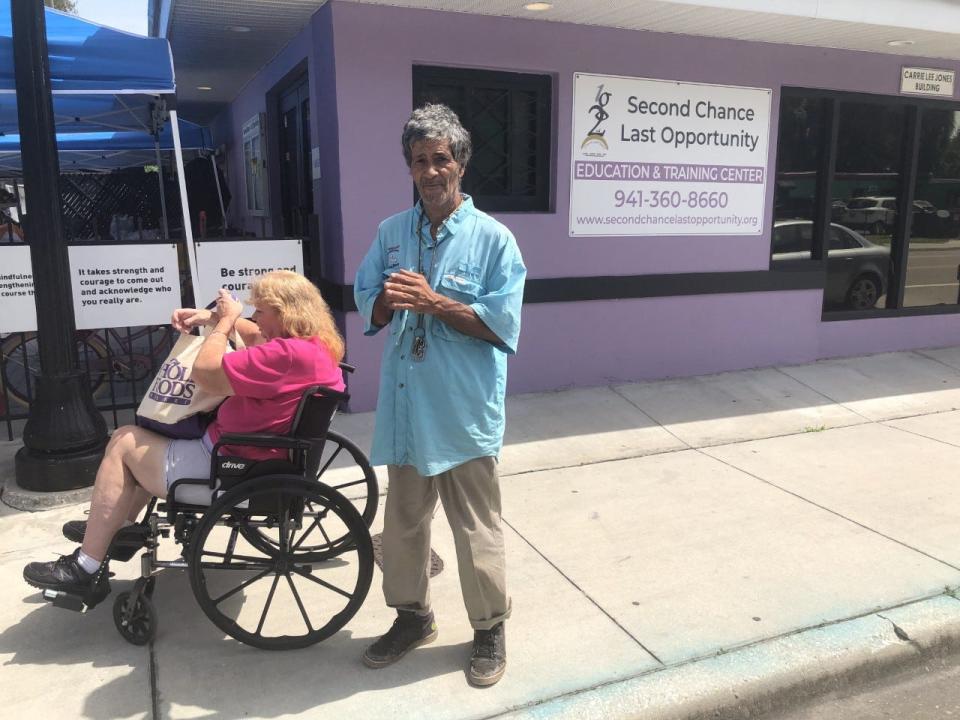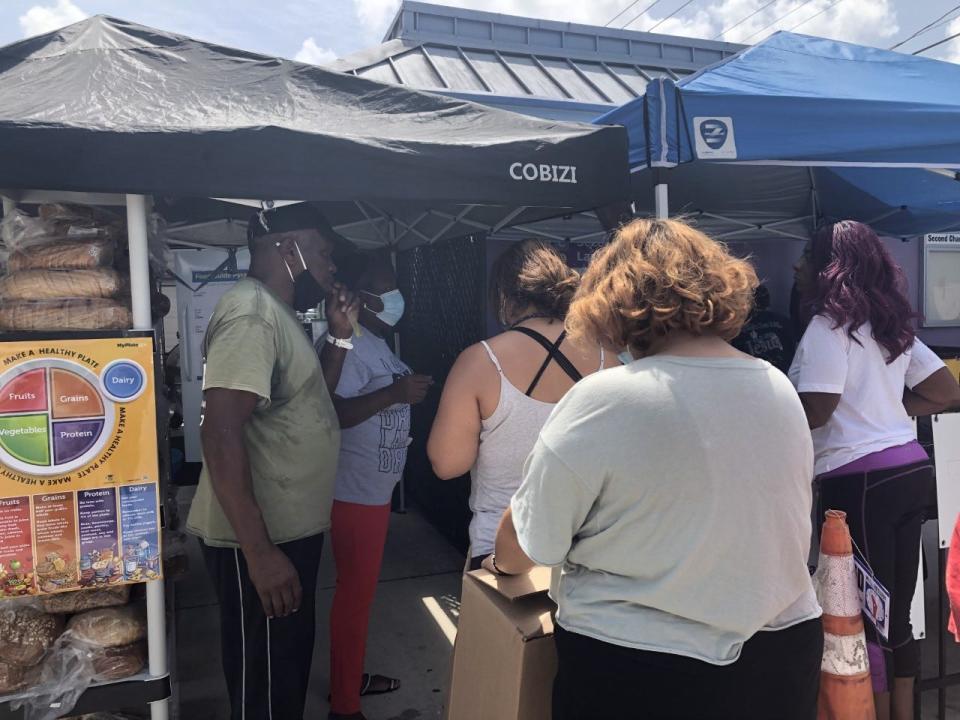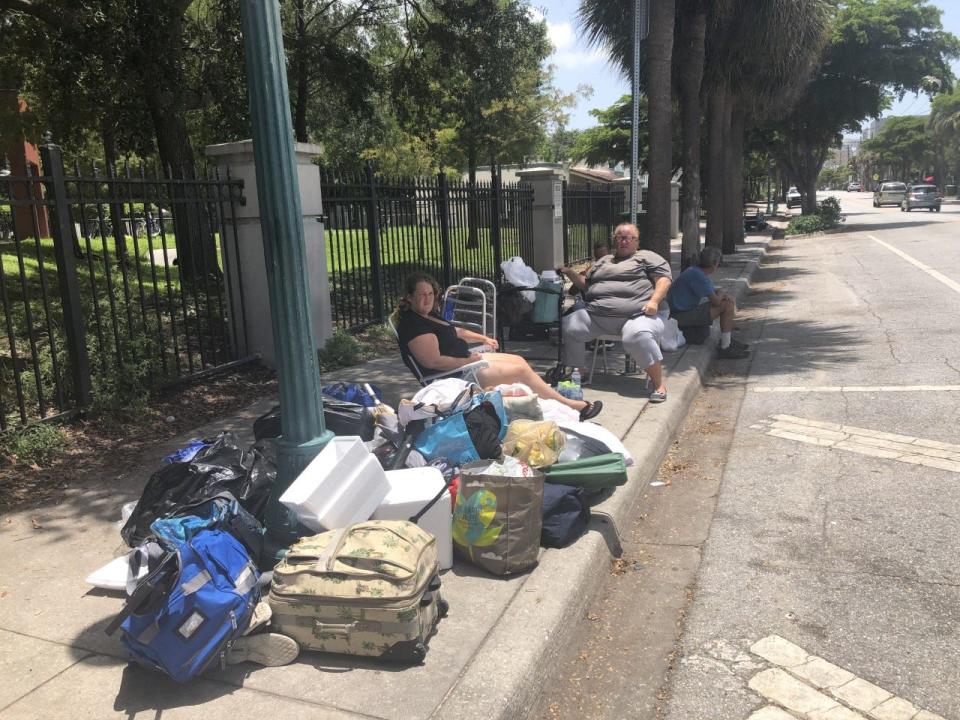The 'heat island' effect magnifies temperatures, misery for vulnerable Sarasota residents
Brenda and Marcos Steiner wait under a scarce tree for the food service to get started across the street on Dr. Martin Luther King Way. A thermometer shows it's 101.1 degrees Fahrenheit in the sun and 97.9 degrees in the shade.
For the last few months the couple has been getting their groceries from Second Chance Last Opportunity. Food in hand, they'll eventually walk back to their house a few blocks down, which uses window AC units that have run up their electricity bill to $350 a month.
It's the most the couple has paid for electricity since moving to Sarasota three months ago. Social Security and retirement help cover their base rent, but after running through their $4,000 in savings during COVID, Brenda said the couple is still recovering from financial woes.
"All these utility bills going up is a bunch of nonsense," Steiner said. "People like us just can't afford it."

From 1996 to 2019, the number of days per year at 90 degree Fahrenheit or above in the Sarasota-Bradenton area has increased by 50%, according to the Sarasota-Manatee Climate Council.
'Heat islands' result of community design
As temperatures rise, residents like the Steiners might also be feeling the effects of heat magnifiers called "heat islands," created through community design. Here, heat is more intense because of lack of trees and green space, the prevalence of concrete, high carbon emissions or out-of-date housing. They are often found in poorer areas of a community that lacks parks, nature trails and other amenities more prevalent in higher-income neighborhoods.
Perilous Course climate reporting: We created scorching 'heat islands' in East Coast cities. Now they're becoming unlivable
Record heat: Sarasota-Bradenton area on track for one of the hottest Julys on record
"One community can be much hotter than a whole other community," said Walter Smith, a Beyond Coal Organizing Representative for the Sierra Club. "The environmental impacts that that holds can be devastating and can literally mean life or death."
Homeless and low-income residents like Brenda and Marcos struggle to stay cool and afford electricity in hotter neighborhoods.
April Glasco, founder of Second Chance Last Opportunity, had to pass out popsicles and water bottles to prevent residents from overheating. The organization has had to open the screening room for those who attend their twice-a-week food service to keep residents cool.
Glasco said a lot of the residents don't have access to the proper clothes for the weather. A lot of them wear the same long sleeve shirt and long pants that don't offer relief from the heat.
"These are people trying to survive the best way they can without having the finances to purchase items," Glasco said.

Glasco was homeless for five years after leaving two toxic relationships. She also struggled with extreme heat since she was living in her car with no air conditioning.
She said she would go into different stores and restaurants just have a place to cool down.
Sarasota adds parks to combat heat island effect
In 2017, the city created it's Climate Adaption Plan to address vulnerabilities caused by climate change. Sarasota Sustainability Coordinator Jeff Vredenburg said the city was one of the first in Florida to publish the report of its kind.
Vredenburg said that although the city code doesn't specifically discuss the urban heat island effect, there are policies that try to combat extreme heat.
"You have to manage the pros and cons of allowing development but also trying to encourage people to have trees and make sure that we're protecting as much natural area encouraging park development," Vredenburg said.
Earlier: Killer heat could alter Florida living
Concerning forecasts: Forecaster: Sarasota to see faster sea level rise, more very hot days in coming decades
In the climate plan the city scored vulnerabilities and their total risk by multiplying the likelihood of the event by the consequences. Although extreme heat was listed as a vulnerability in the plan, it wasn't considered a prioritized vulnerability in the report.
The city said it's made an effort to address the heat island effect in the area by adding parks throughout the city, including the Rosemary Park and The Bay, a 53-acre waterfront park that's under construction.
Green spaces and grassy areas not only tend to be cooler because of the shade, but also because trees use the carbon emissions that can make it hotter, Smith said.
Access to shade needed
Glasco said that the creation of The Bay may be convenient for those who can afford it. Homeless people don't have the same luxury of going to the park for shade with the stigma they experience, she said.
"It's convenient for (some) but not for people that are homeless. What do they have where they can say, 'I need to get some shade.' Where are they allowed to go if they're not accepted to be at certain areas?" Glasco said.
According to a Sarasota County ordinance, unpermitted "camping" is unlawful, and "unpermitted camping on public lands and facilities such as parks, beaches, preserves, libraries, office buildings, and transportation facilities interferes with public access and their intended public purpose."
The city defines camping as using bedding or other materials to sleep; using a tent or other temporary structures to sleep; or having numerous personal belongings in the bedding, temporary shelter or other similar items.
Tila Casrell sits outside the Salvation Army at 1400 10th St. with her daughter under some trees. It's 114.8 degrees Fahrenheit in the sun and 95.2 degrees in the shade, according to a thermometer the Herald-Tribune used to measure air temperatures. She said her family has been homeless for the last four years.
"We try and find shade, but there's hardly no shade around here," Casrell said. "And if we're not near our stuff, they'll take it so we can't move too far."

Casrell said that they need areas of shade where they won't be told to leave by law enforcement.
"We need more water and better services -- one like a field with a park or something with shade that we can all go into and the cops don't tell us to leave," Casrell said.
Every so often someone will give water to them, but she said it's been difficult for her family to get access to water. Most places in the area charge for water, and every penny counts as the family tries to survive, Casrell said.
"We need this water. One day it felt like it was like 150 degrees out here," Casrell said. "Nobody had no water. We're all sitting here hot burning up and asking everybody for water and everything."
Katherine Norman, group chair for the Manatee-Sarasota Sierra Club chapter, said that it's important to prioritize people over development.
It's wrong to put homeless people at risk from "environmental hazards on our streets," Norman said. "It speaks very negatively about our city, and regardless of what we're doing now, more has to be done."
Glasco said it's not fair for people to judge homeless people and the circumstances that might have led to them becoming unhoused. She said those who are experiencing homelessness deserve to have a quality of life.
"Shade or no shade, everyone deserves a second chance and deserves to be treated right."
This article originally appeared on Sarasota Herald-Tribune: Sarasota 'heat islands' effect magnifies heat, impacts residents

